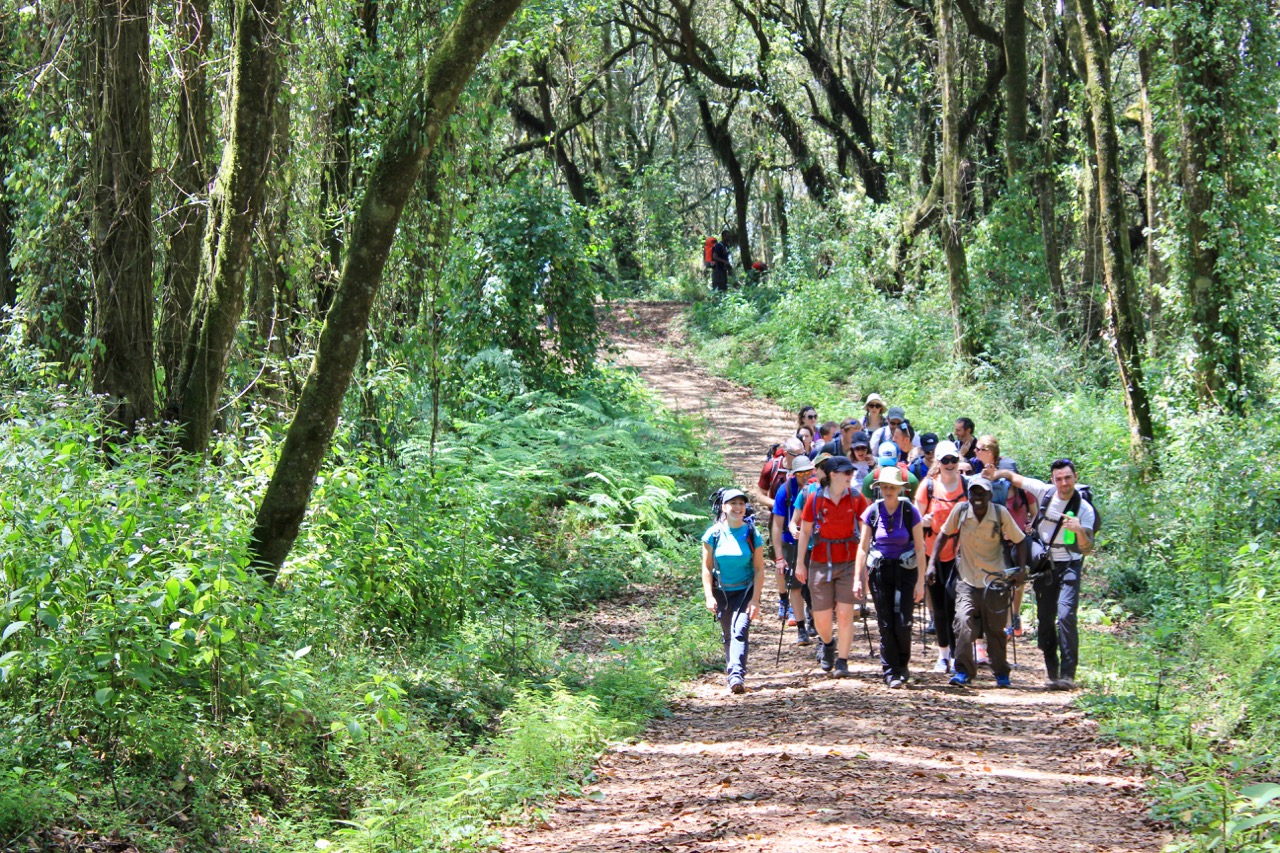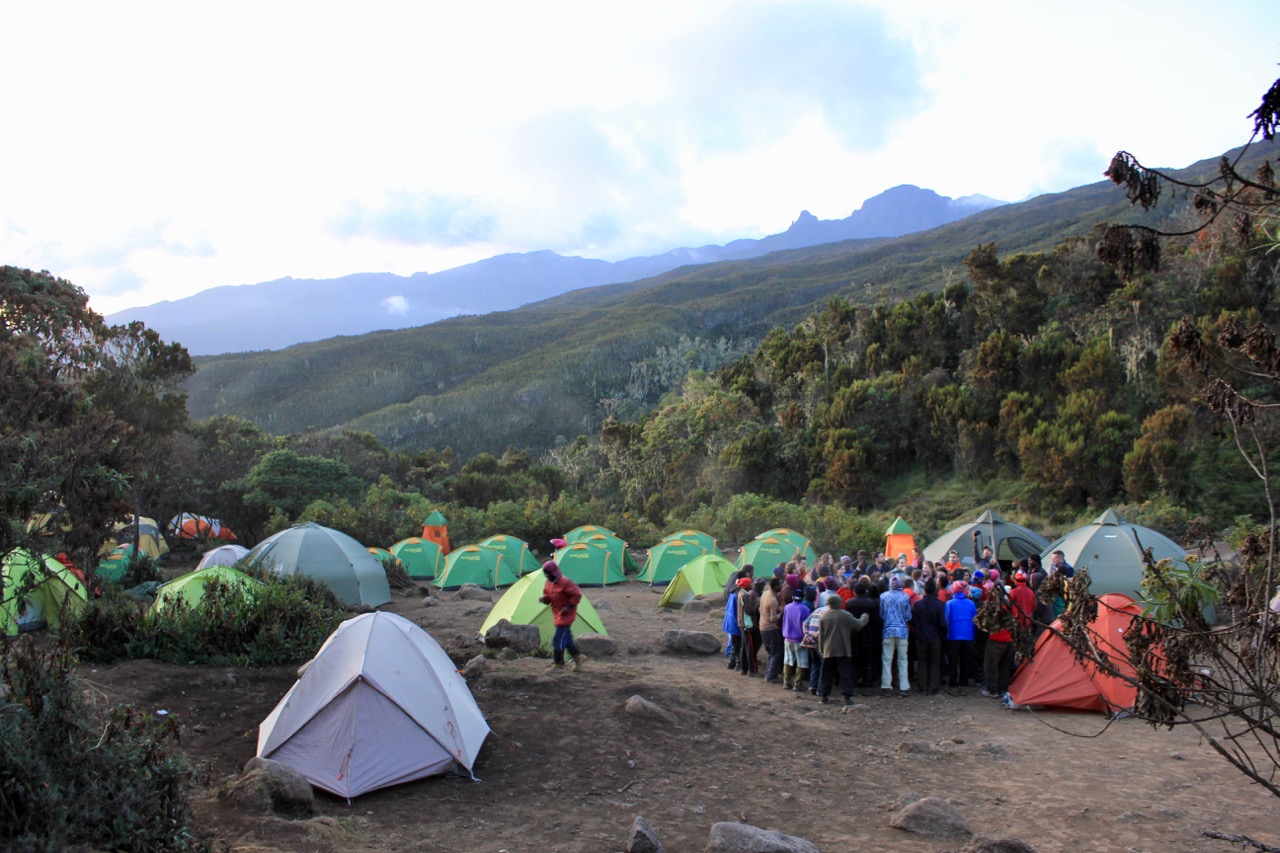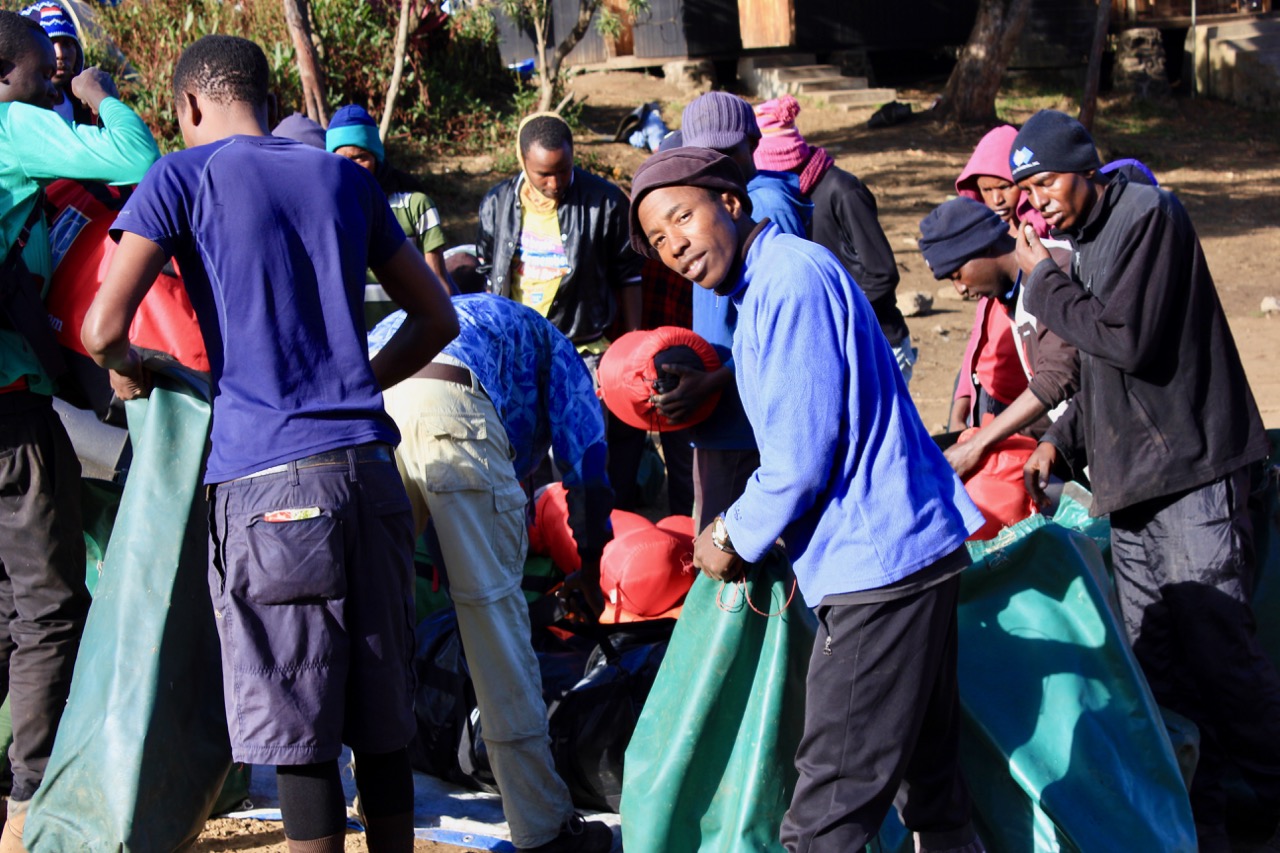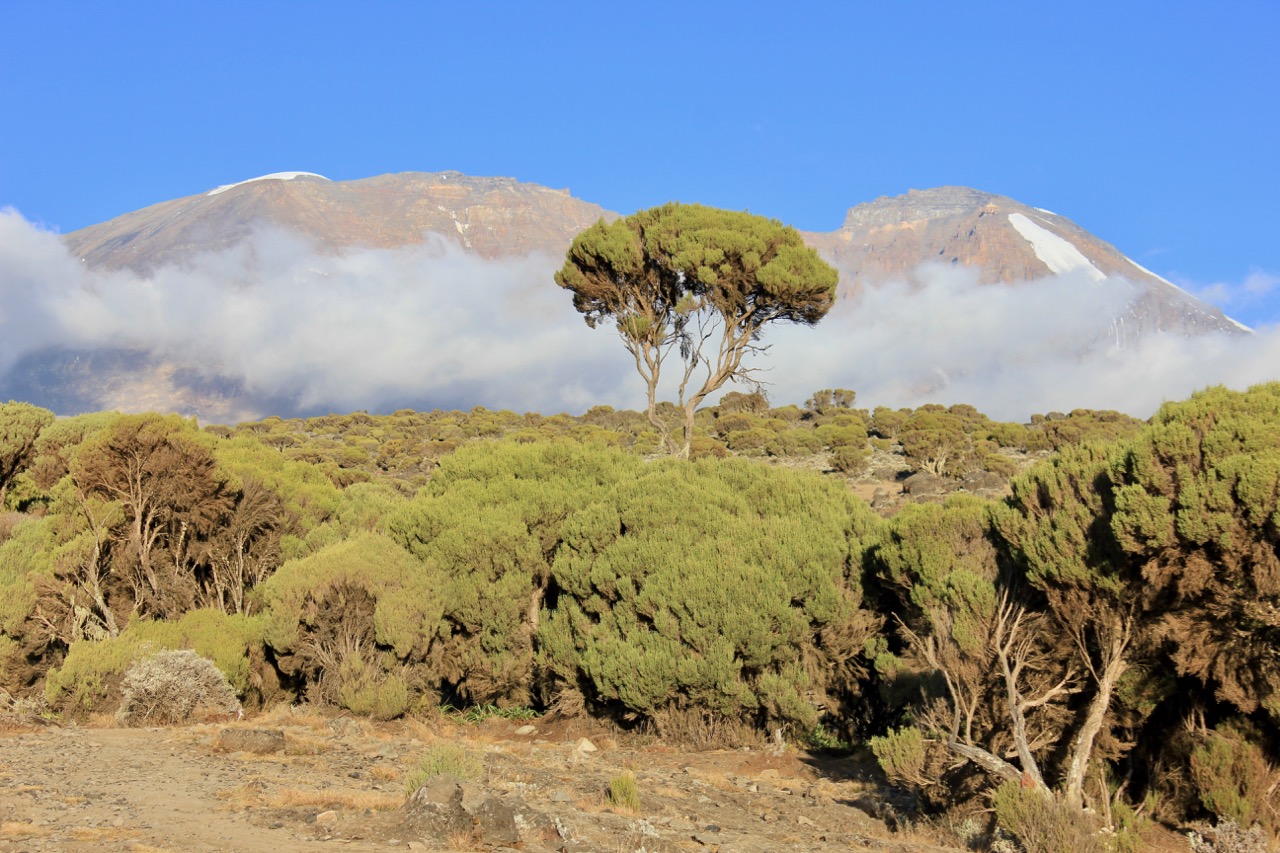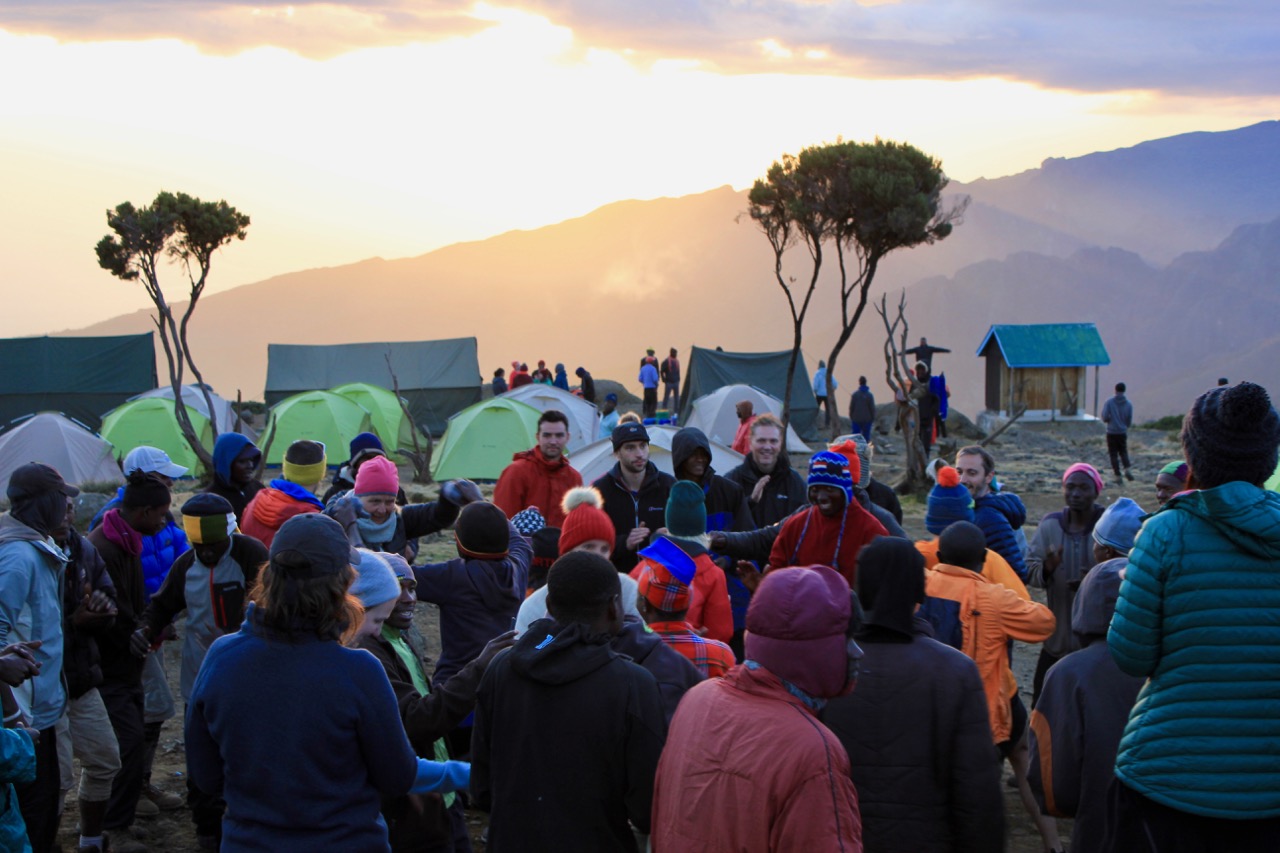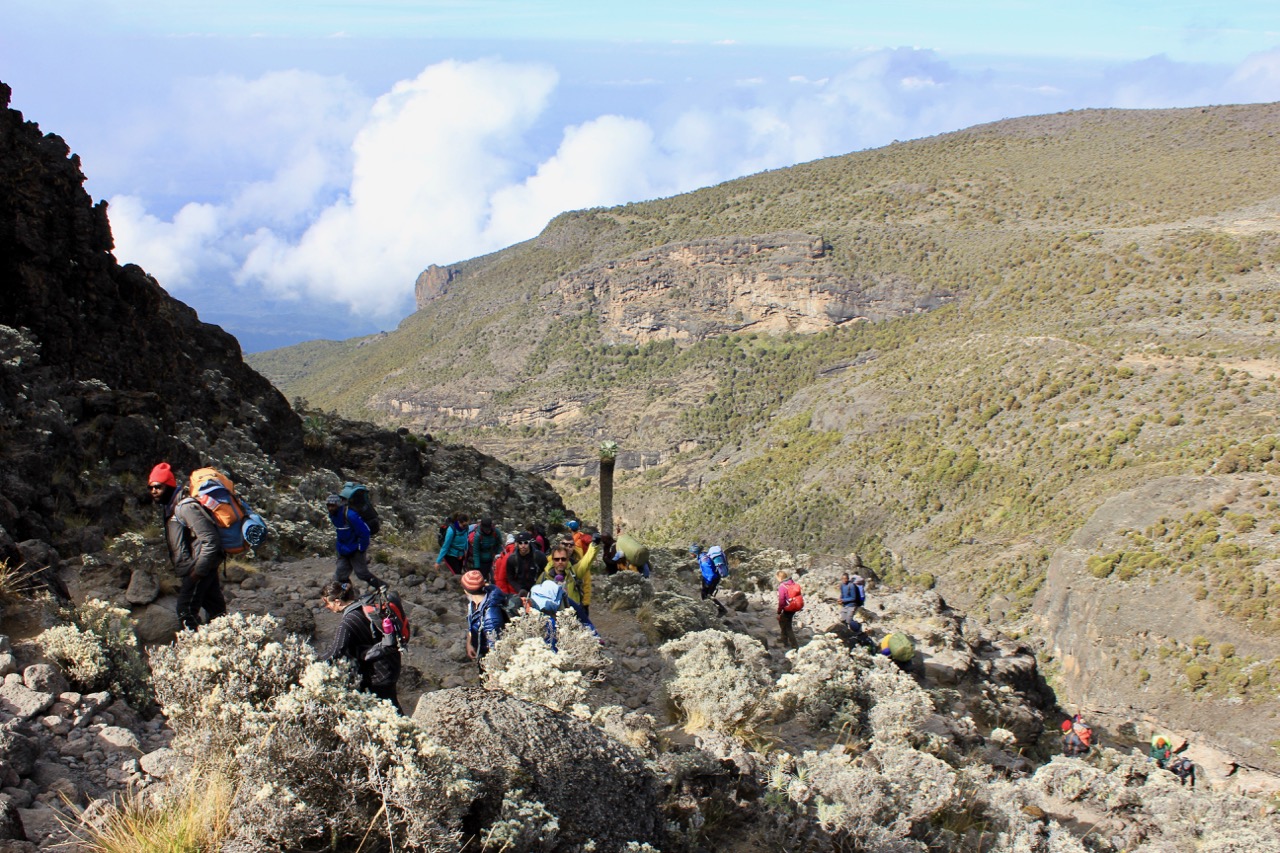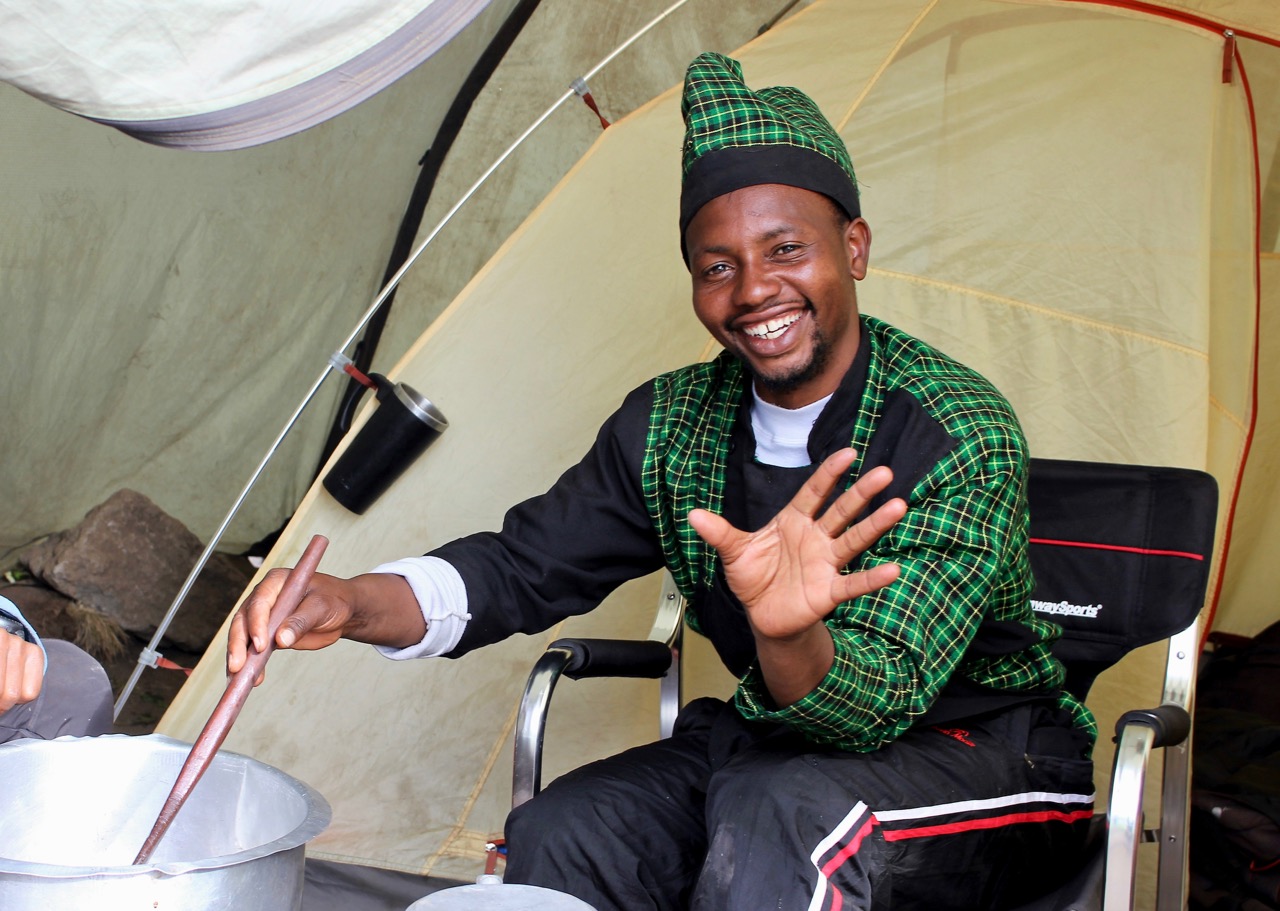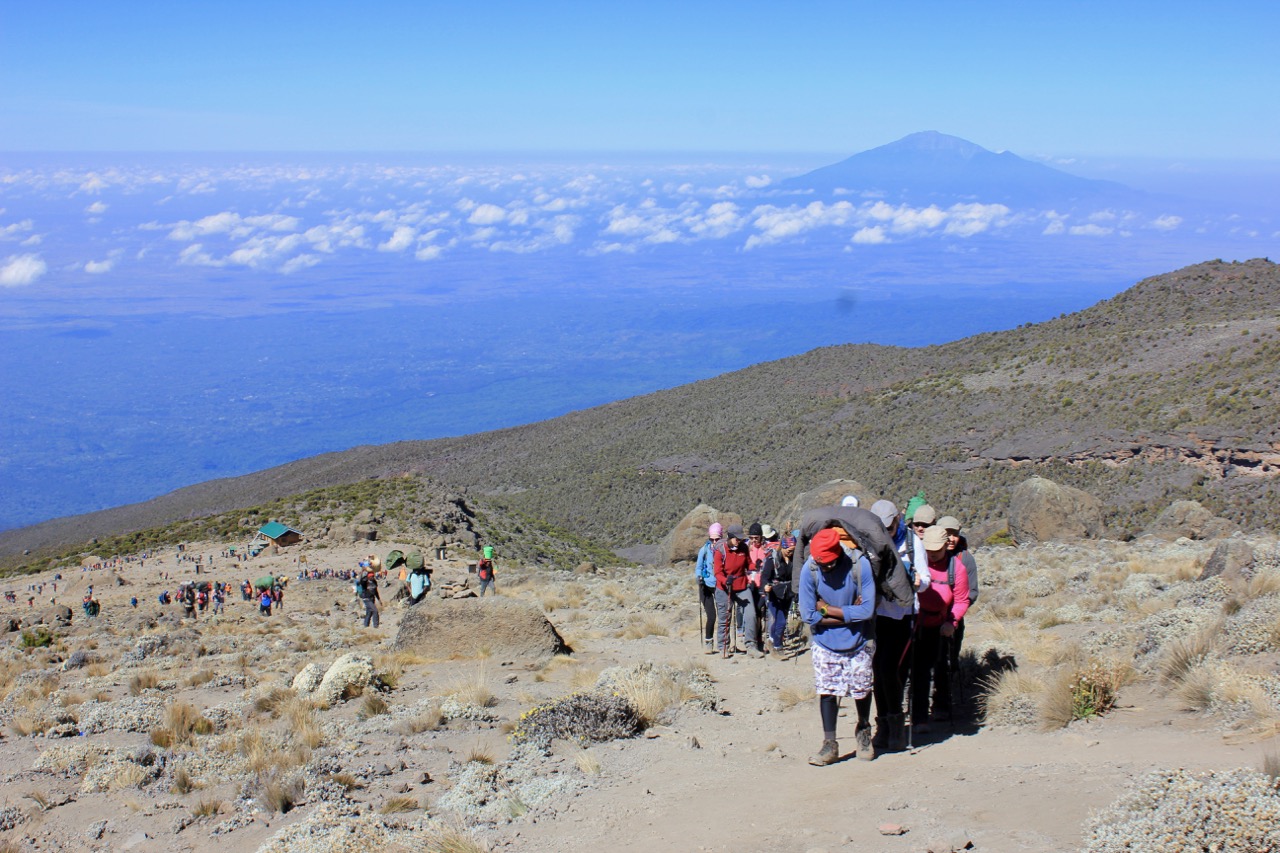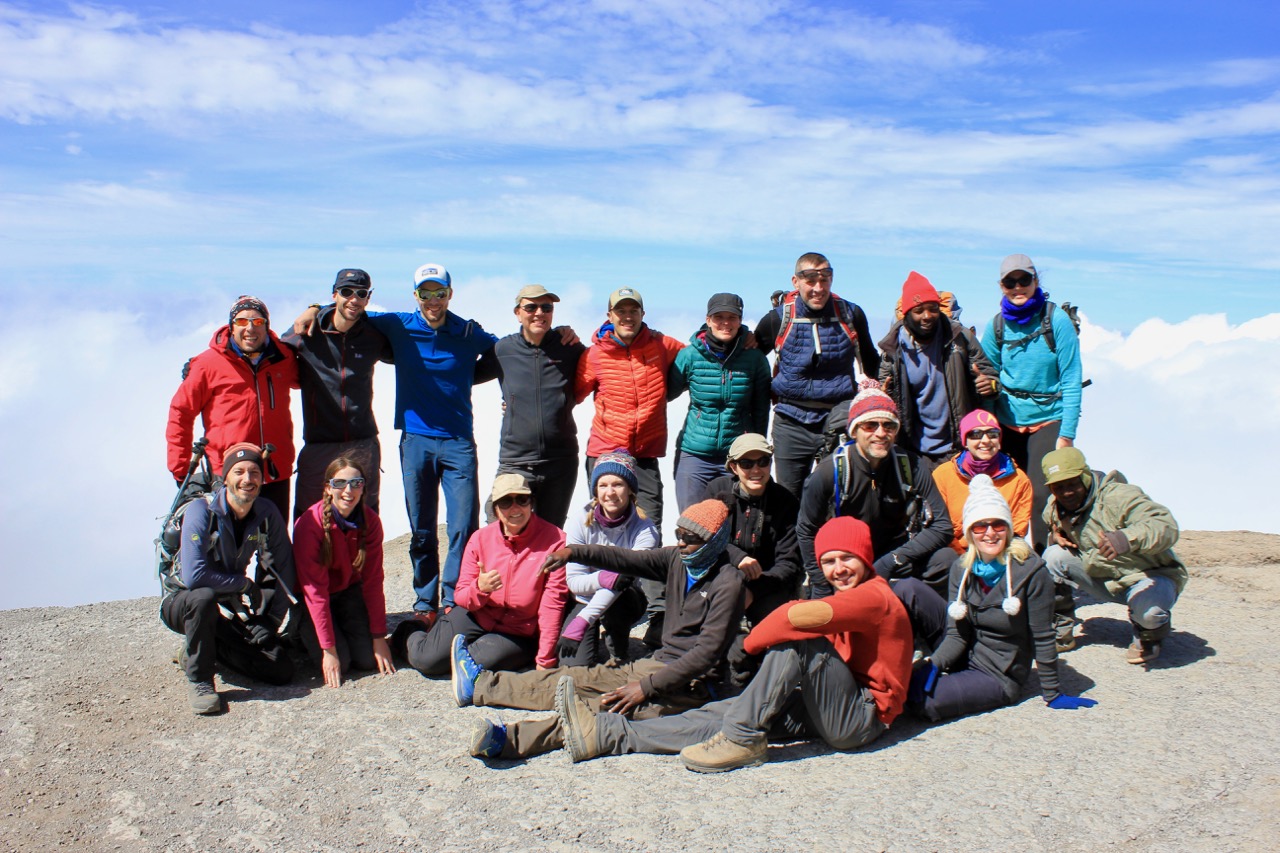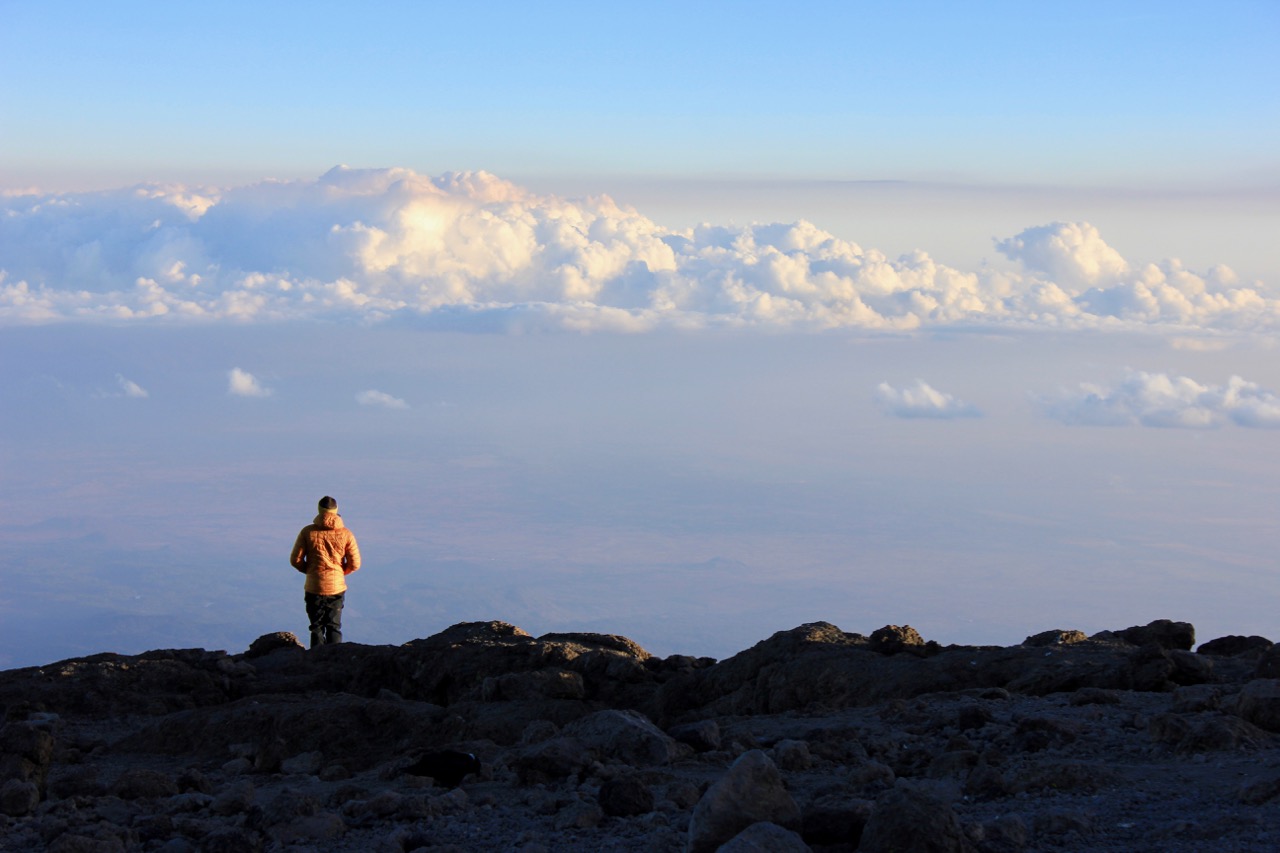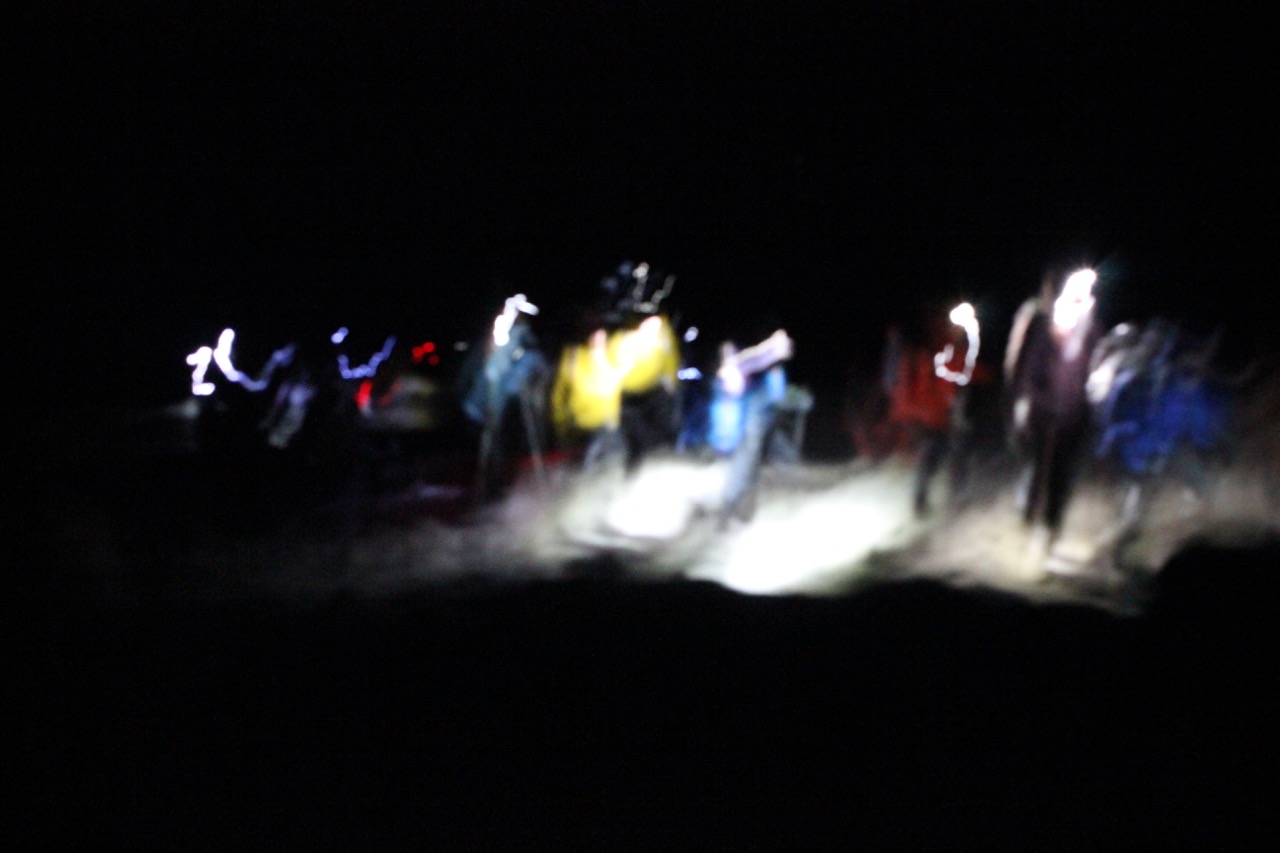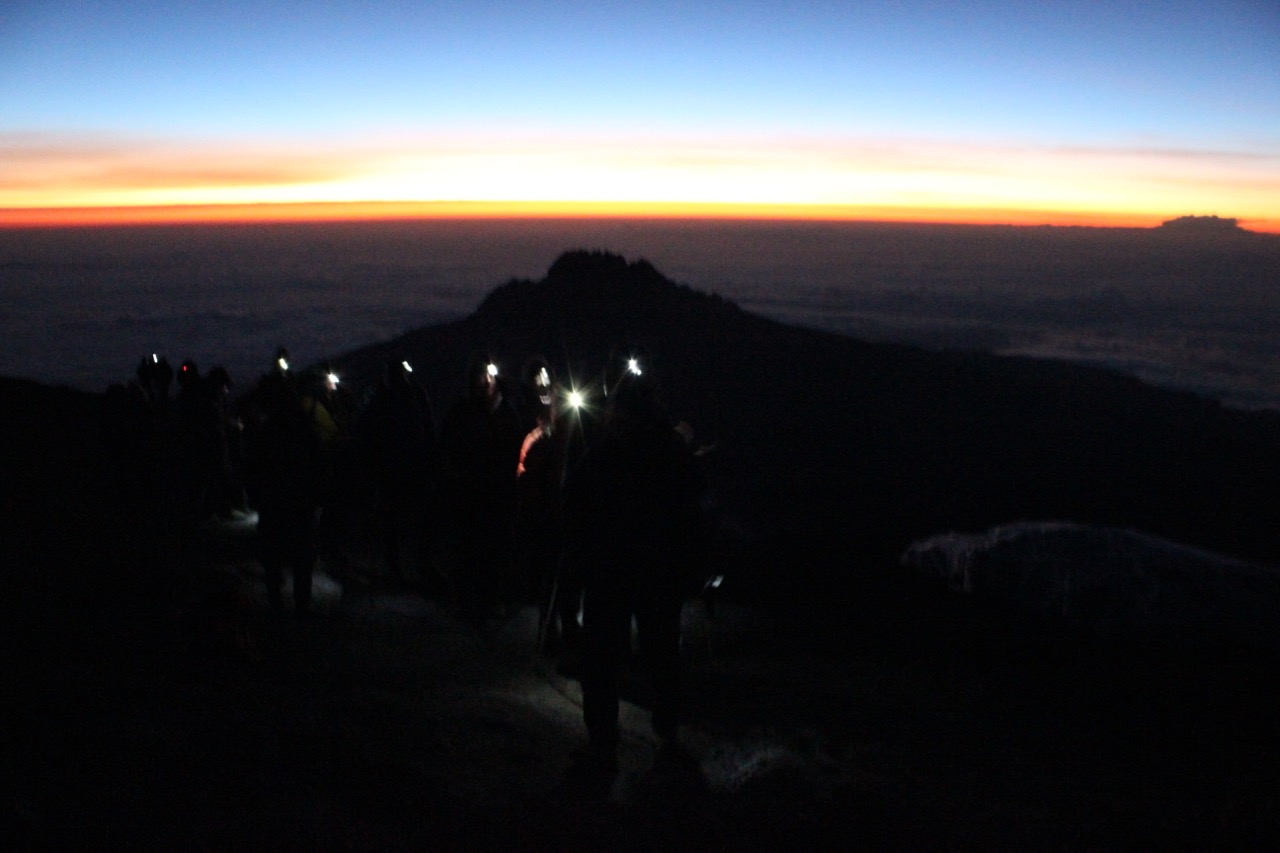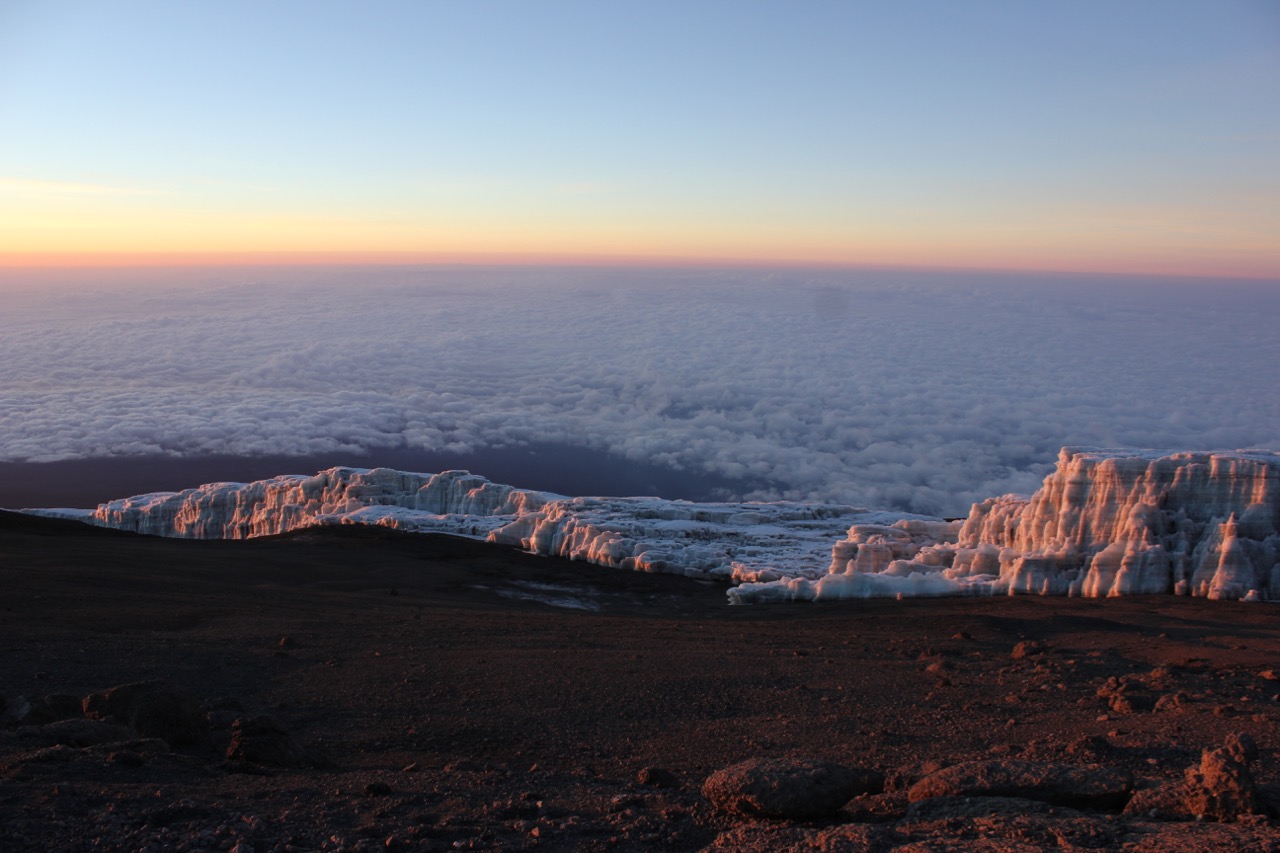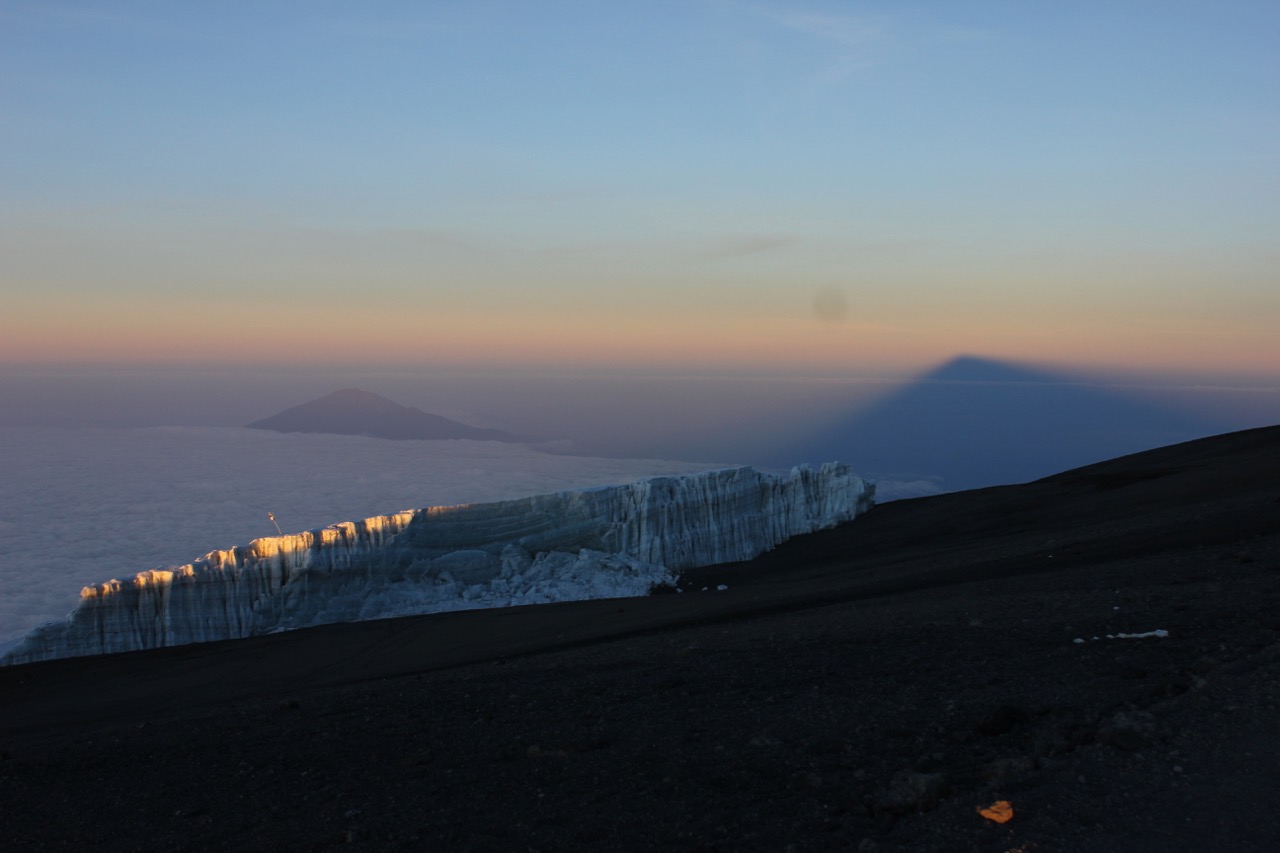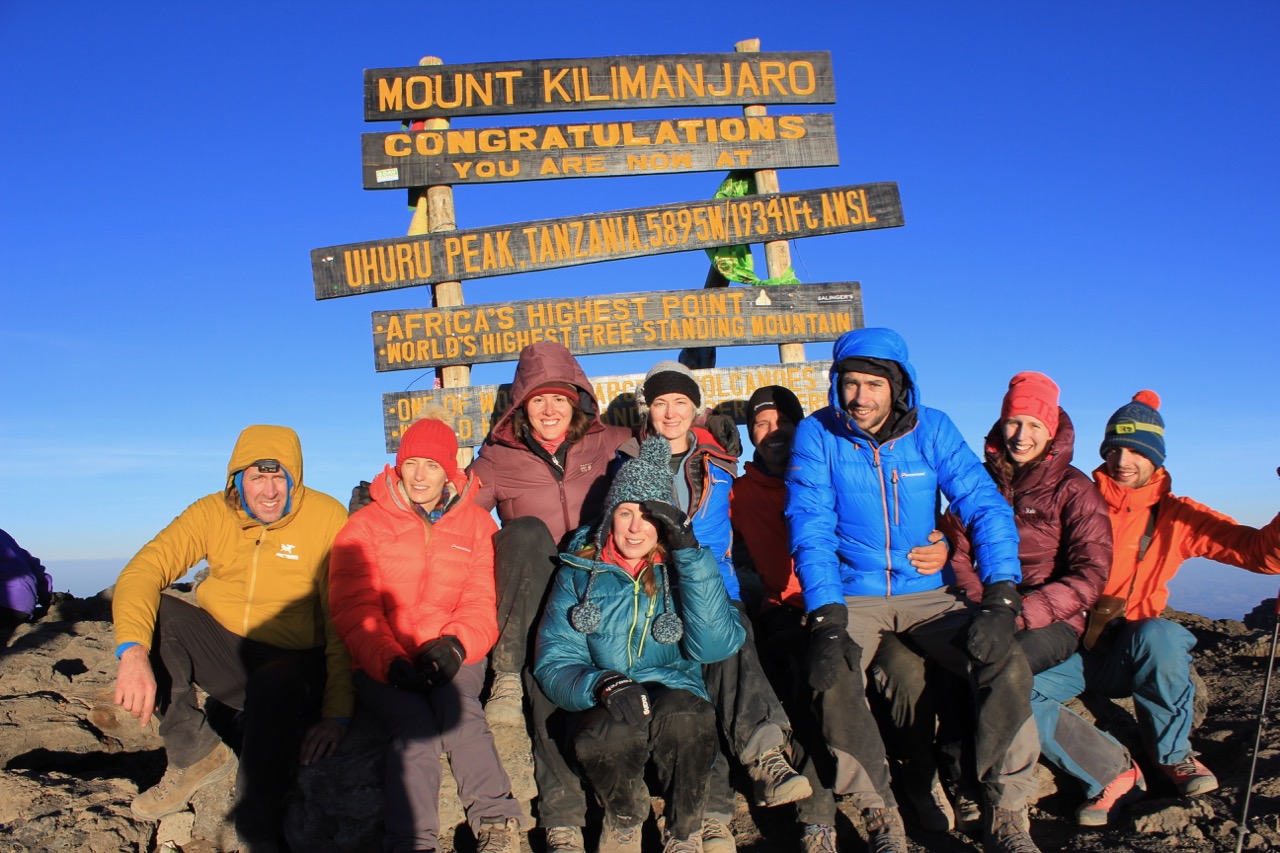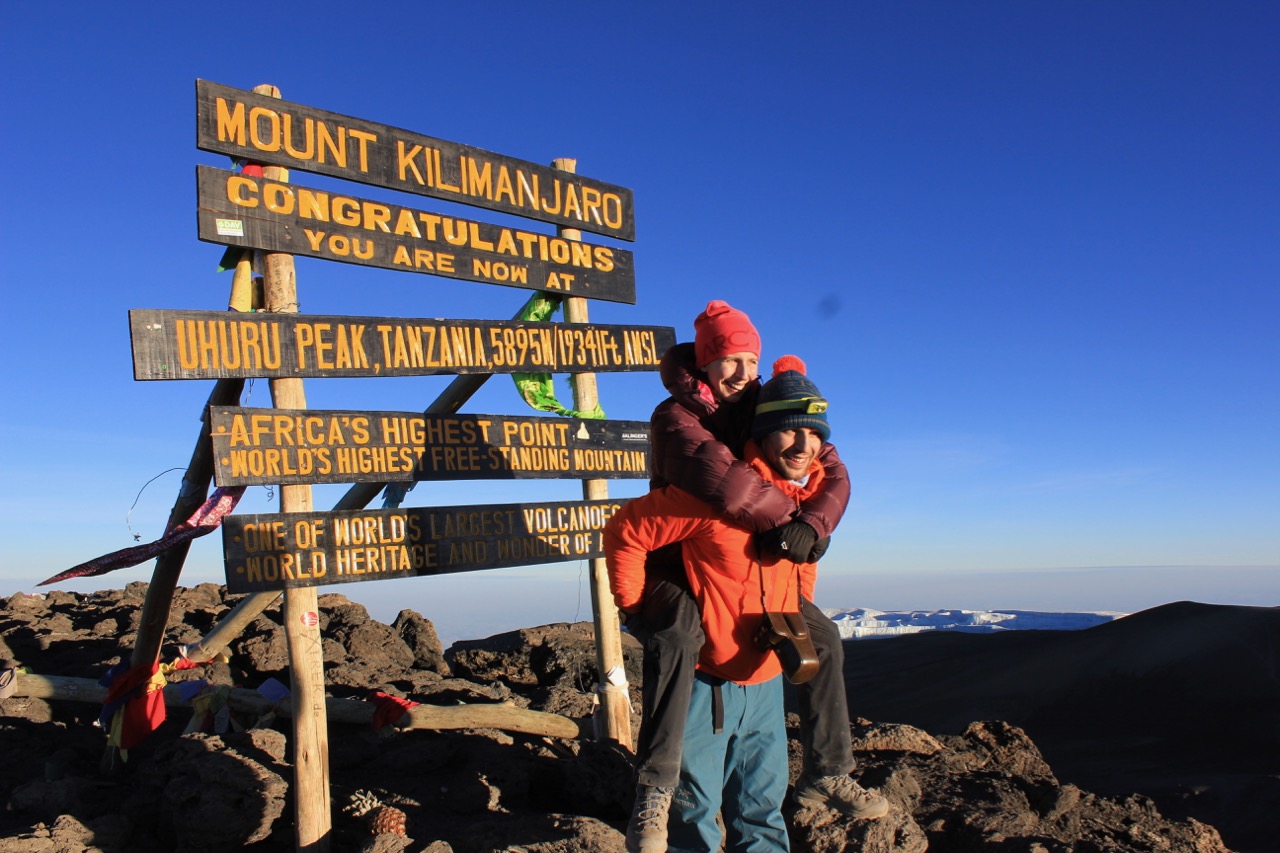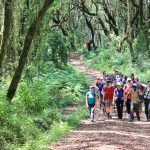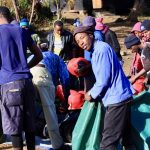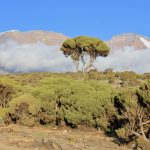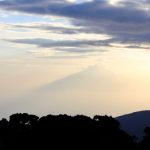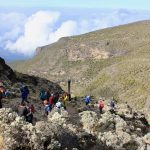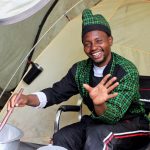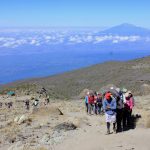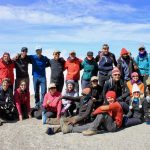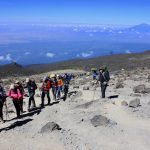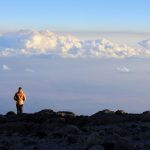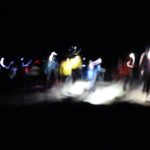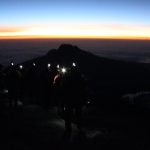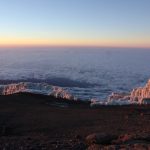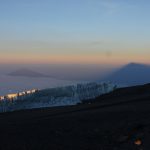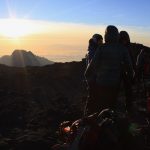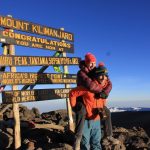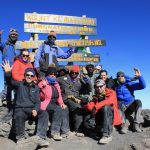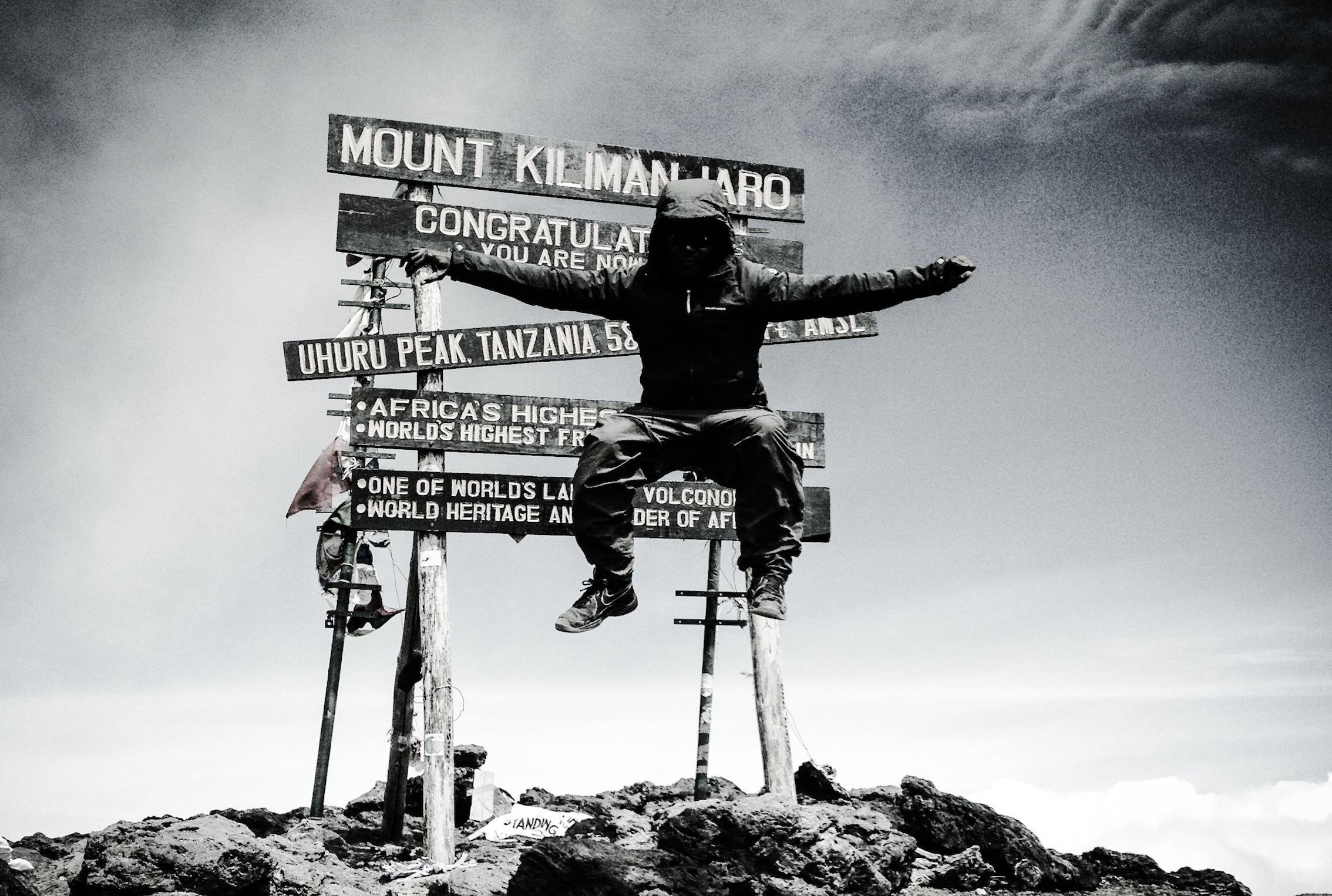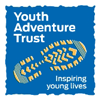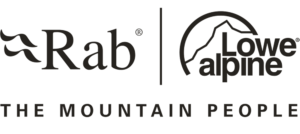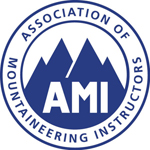Overview
Kilimanjaro is the worlds highest free standing mountain, the highest mountain in Africa and one of the famous 7 summits!
Climbing Kilimanjaro is a truly special experience. At the park gate we’ll enter into pristine rainforest and during the trek we’ll pass through shrub, desert and alpine environments. Over our 7 day route we’ll gradually gain altitude, acclimatising to our new surroundings and enjoying incredible views across the african plains. With unprecedented support from Mountain Expeditions and our local team, excellent logistics and plenty of singing and dancing along the way, Kilimanjaro is an experience you’ll never forget!
Organised and lead by Mountain Expeditions
Mountain Expeditions are expedition specialists and Kilimanjaro is where it all started for us! We love organising and delivering expeditions to ‘Kili’ and do so with a friendly and supportive approach. We understand that joining any of our expeditions is a big deal, so we try and make sure everything is perfect from start to finish.
Local Mountain Guides
The truth behind organising and leading worldwide expeditions is that you need an excellent local in-country agent to work with who shares your ethos of delivering outstanding expeditions. Our Head Guides Julio, Bryson and Mussa and our Basecamp Manager Michael have been working with Mountain Expeditions teams since 2008 and are integral part of our Kilimanjaro Family. Our relationships have grown over many expeditions and formed a strong working partnership. We know you will love spending time with them on the mountain.
Fully supported by local cooks, porters & guides
Over the years Mountain Expeditions have developed a long standing relationship with our local crew in Tanzania and the added value of our friendly and efficient local staff never goes unnoticed – we know it makes a big difference to your experience. Our local team are a huge part of your Kilimanjaro experience and will be with the team throughout the entire expedition. Mountain Expeditions are trying to set new standards on Kilimanjaro by ensuring that the local crew working with our groups are properly kitted out and well looked after on the mountain – we offer them the chance to borrow good footwear and the kit & equipment they need to use whilst working with our groups.
“If ethical travel is what you’re looking for in a company, then look no further than Mountain Expeditions. The guides and porters were so much a part of the team that you could tell it was like a big happy family” – Marcus Samperi
Very high summit success rate
With over 40+ expeditions on Kilimanjaro we have an impressive 98% summit success rate. We believe this is because of our combination of smaller teams, higher guide ratios and using the most experienced High Altitude Expedition Leaders. This combination has shown time and time again that this is the safest approach whilst on the mountain.
11 day itinerary with a 8 day trekking route
Our itinerary has been chosen to make this trip the very best we believe it can be. We include an entire preparation day in Moshi which allows time for people to rest after a long flight, time for any lost luggage to catch up with us and time for your Expedition Leader to do a full kit and medical check before a relaxed expedition briefing with a cold Kilimanjaro beer!
On the 8 day Lomosho Route there are climb high sleep low days, 2 shorter half days before your summit attempt and of course – some big days! Overall it offers the best acclimatisation profile of any route on Kilimanjaro.
The perfect first big mountain
There are many reasons people choose to climb big mountains and many reasons why you might choose to trek up Kilimanjaro. What we can tell you is that choosing Kilimanjaro offers you a realistic opportunity to summit a big mountain without any altitude experience.
Accommodation: Hotel, lodges & tents
Many of our expeditions start and finish in a bustling city in a really nice hotel or lodge. Maybe it’s first and last impressions that count or perhaps we just enjoy having nice accommodation when starting and finishing a trip but it’s what we do! On Kilimanjaro we use our favourite lodge after the trek and ensure that camplife is as comfortable as possible on the mountain. Refer to the FAQs tab on this page for more details.
Trip Suitability
Kilimanjaro is a tough mountain to climb and, although it is a mountain peak that doesn’t require technical mountaineering experience, a good level of physical fitness is necessary. The Lomosho Route is a fantastic route to trek but it has quite strenuous parts. To join the trek and maximise your chance of reaching the summit, we recommend:
- You have a clean bill of health
- You have a good level of fitness (more on this below)
- You have experience walking up hill in a mountainous environment for several hours at a time
In preparation for any mountain expedition, we offer Expedition Specific Training courses in both summer and winter. This is a great chance for you to spend time in the UK mountains with an experienced Expedition Leader and learn some new skills, getting better prepared for you next big expedition objective. If you have booked on to an expedition with us already, then we offer a 10% discount on these courses.
Training for Kilimanjaro
The best training possible is getting out in the mountains themselves. Previous experience in the hills and mountains is hugely beneficial, but climbing stairs and long runs also count!
One of the fastest ascents of Everest was made by a London businessman who trained 1 hour a day for 9 months climbing the stairs of a 24 storey building with a loaded rucksack, so think creatively: Covent Garden Tube Station has 193 steps; Box Hill is just a 50 minute train journey from Central London. Walking, cycling, Cross-Fit – in fact any fitness training will be of benefit to you. Focus on cardiovascular fitness and lower body strength. Long walks and runs are ideal training.
We can help you with a training plan but essentially you will need to be comfortable trekking with a small rucksack for several hours at a time in hilly terrain. If you are unsure of whether you fall into this category, please contact us and we can have a chat about it.
A good indication of both physical and mental fitness is being able to run 10km in 1 hour
Itinerary
The itinerary below is intended as a guideline only, although every effort will be made to adhere to it, changes may be forced upon it by weather conditions, transport failure or other unforeseen events. You should be prepared to be flexible where necessary.
Additional days – if you wish to arrive early or stay an extra day then please let us know and we can book the Weru Weru River Lodge accordingly. The price is $90 for a single, $130 for a twin.
Day 1: 6th September – Arrival & transfer to Weru Weru River Lodge
Upon arrival into Kilimanjaro Airport, you will be met by our driver with a large ‘Mountain Expeditions’ sign board just as you exit the terminal. There are toilets both inside and outside the arrivals terminal should you need them. The transfer to the Lodge in Moshi normally takes between 45 min – 1 hour. After settling into the rooms, there is an open bar area, swimming pool and beautiful grounds to relax in. Dinner is at the hotel from 7pm.
Day 2: 7th September – Preparation day
You’re head guide (either Bryson or Julio) will come and meet you in the morning. They will deliver their expedition brief and answer any questions you may have. They will also do a kit check and ensure you have all the necessary clothing and equipment required for the trek. For those of you who would like too there will be the opportunity to explore the local town of Moshi. It’s only a 20 minute drive and here you have the chance to change money, drink a coffee and pick up any last minute bits and pieces you may need for the trek.
Today only you will need to arrange your own lunch (either at the hotel or in Moshi – I like a place called Coffee Union in Moshi). Dinner is included at the hotel.
Day 3: 8th September – Londorossi Gate to Mti Mkubwa (2,800m)
After breakfast at the hotel it is a three-hour drive to the Londorossi National Park Gate, located on the western side of Kilimanjaro. Register at the gate office, and start the hike with a gradual ascent and a slight descent into the Lemosho Glades. Enter the lush rainforest and listen to the sounds of many exotic birds. Spot monkeys such as the black and white colobus – these monkeys are black with a long ‘cape’ of white hair and a flowing white tail. Spend the day in the gorgeous and fascinating forested slopes of Mt Kilimanjaro, most of which is considered to be a rainforest zone. End the day at the Mti Mkubwa (Big Tree) Campsite, within the upper reaches of the montane forest zone.
Trekking time 3 – 5 hours; Distance: 5km
Day 4: 9th September – Mti Mkubwa to Shira One Camp (3,500m)
Rise early and tackle a steep climb to head out of the montane forest zone and into the moorland zone. Admire trees such as the Giant Heather and Erica. Embark on a challenging hiking day with a trek over the Shira ridge at 3,500m, where, on a clear day, have direct views of Kibo, the peak and ultimate goal of the adventure. From there, descend to the Shira plateau and set up at Shira 1 Camp, located next to a stream.
Trekking time 5 – 6 hours; Distance: 9km; Campsite altitude gain: 700m.
Day 5: 10th September – Shira One Camp to Shira Two Camp (3,800m) via the Cathedral
You hike east across the Shira Plateau, making a detour towards the plateau’s southern lip to ascend Shira Cathedral (12,470ft / 3,880 m) before reaching Shira Two Camp. During the day you ascend gently through the lower alpine moorland, which is notable for beautiful wild alpine flowers and the unique giant lobelia and giant groundsel (senecio kilimanjari) plants.
Trekking time 3 – 4 hours; Distance: 5km; Campsite altitude gain: 300m.
Day 6: 11th September – Shira 2 Camp (3850m) – Barranco Camp (3985m)
The landscape begins to get far more rugged today as we continue through rolling semi-desert valleys passing the impressive Lava Tower, a volcanic plug that towers over the trail at 4642m.
Trekking time 5-7 hours; Distance: 10km; Campsite altitude gain: 135m.
Day 7: 12th September – Barranco Camp (3985m) – Karanga Camp (4040m)
Today is the perfect opportunity for you to continue acclimatising, with a relatively easy trek and very little height gain. After a morning walking along the Kibo South Circuit, we enter the Karanga Valley and to our riverside campsite. There may be the opportunity for a further acclimatisation trek in the afternoon if you’re feeling up to it.
Trekking time 4-5 hours; Distance: 5.5km; Campsite altitude gain: 55m.
Day 8: 13th September -Karangu Camp (4040m) – Kosovo High Camp (4800m)
A climb over rocky slabs leads to Kosovo High Campsite (4800m) where we get an early night for our summit attempt the following day. If the conditions allow, we may get views of the spectacular Heim, Kersten and Rebmann glaciers above. Tonight will be cold, so after some food and hot drinks, we retire to our tents early to get as much sleep as possible before the long day ahead.
Your leader will deliver a detailed summit brief with top tips and handy hints. It is essential to have your daypack and water ready before bed.
Trekking time 4-5 hours; Distance: 7km; Campsite altitude gain: 760m.
Day 9: 14th September – Kosovo High Camp (4800m) – Uhuru Peak (5895m) – Millennium Camp (3820m)
Summit day has arrived! We begin with a very early start for our final push, passing the Rebmann Glacier then on to Stella Point as the sun rises over this dramatic landscape. A short while after this, we reach Uhuru Peak – the highest point of Kilimanjaro and of the African continent. What an achievement – you’ve made it to the summit! Providing it is clear, the summit offers magnificent views of the sun rising over the secondary cone of Mawenzi (5149m) and west over the vast plains to Mount Meru (4566m). After a brief photo stop and a rest, we begin a descent back down the way we came up to Barafu Campsite for lunch then onto Millennium Camp where we camp for the final time.
Trekking time 10 hours minimum; Distance: 15km; Ascent: 1072m; Descent: 2075m.
Day 10: 15th September – Millennium Camp (3820m) – Machame Gate (1830m)
During our last day trekking, we descend from Millennium Camp all the way down to Machame Gate where we’ll say our goodbyes to some of our local team before being transferred back to our hotel for showers and a celebratory meal.
Trekking time 5 hours; Distance: 20km; Descent: 1990m.
Day 11: 16th September – Transfer to airport & trip ends
Today we say our goodbyes and you will be transferred to the airport for your return flight.
Map
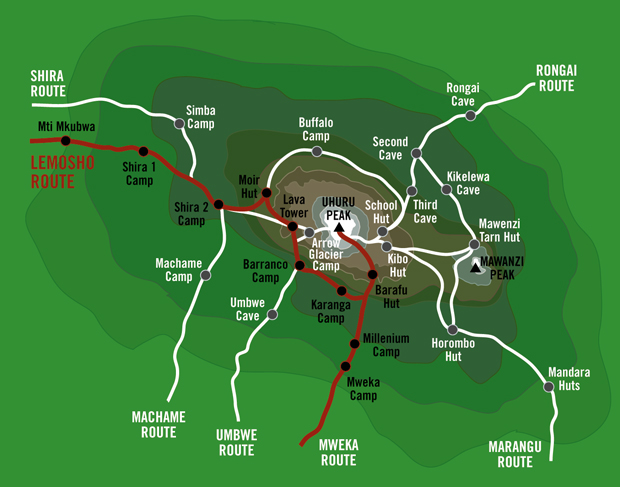
Included
When you book with Mountain Expeditions, we want you to know exactly how much the trip is going to cost you, with absolutely no hidden extras or last-minute costs. Our fully inclusive land-only price includes almost everything from the minute you land at Kilimanjaro International Airport until the time when we drop you back – there are no hidden extras!
The following are included in our price:
- Local Guides, Assistant Guides and Porters – Mountain Expeditions pay fair wages for porters and guides and are approved by Kilimanjaro National Park, Kilimanjaro Porters Assistance Project, as well as Tanzania Association of Tour Operators
- Return in-country airport transfers
- All meals in-country except one lunch during the preparation day
- A dedicated cook and assistant cook
- Three nights accommodation in Moshi (2 nights before, 1 night after)
- Transfers to and from the park gates
- All National Park entry permits and camping fees
- Six nights camping on the mountain
- Camping equipment (a 4-season tent, camping mat and a -22°C sleeping bag)
- 2 x private portaloo toilet tents on the mountain
- Clean Katadyn filtered water
- Emergency equipment – comprehensive first aid kit, medicine, oxygen and radios
- Rescue cover for Kilimanjaro National Park
You should also refer to the Not Included section.
Not Included
The following are NOT included in our price:
- International flights to Kilimanjaro International Airport (JRO)
- Tanzania visa, $50 USD*
- Travel insurance
- Tips $200 USD (these are compulsory)
- Personal spending money
- Drinks from the bar(s)
- Lunch during your preparation day
- Pre-trip inoculations / malaria prophylaxis
- Personal equipment & kit – please refer to the Kit List
- Any additional costs associated with leaving the expedition early
*We recommend that you get your visa before arrival as the queues can be long and very slow, it is however possible to get your visa on arrival. If you do this you will need $50 USD in cash. Refer to the FAQs section for more details on your visa.
If you require any advice or help with any of the following then please head to our Kilimanjaro FAQ tab as well as heading to our general expedition FAQs section, or simply Contact Us and we can help.
Difficulty Level
All of our UK Courses & Worldwide Expeditions come with a suggested difficulty level to help you choose the correct one. For a full explanation of the Scottish Winter, Alpine and UK Rock Climbing grading systems, this blog explains them all – Grades Explained
Grading for UK Courses
With all our UK courses please refer to the Trip Suitability section for more specific details on course expectation and technical and physical levels required.
C1 – Intro Course: open to any level and ability
C2 – Intermediate Courses: previous experience of scrambling/rock climbing or winter mountaineering
C3 – Advanced Courses: previous technical summer or winter climbing experience
Grading for Worldwide Expeditions
With all our Worldwide Expeditions you should refer to the Trip Suitability section for more specific details on the expedition expectation and technical and physical levels required. If in any doubt please don’t hesitate to contact us.
Physical
A. Good basic fitness, as for UK hill walking and mountaineering. Average rucksack weight: 6-8 kg
B. Good cardio-vascular fitness which for most people requires some training, by running, hiking and perhaps some gym work. Average rucksack weight: 8-12 kg.
C. High level of fitness coupled with physical toughness and the ability to carry a heavy rucksack for long periods. Average rucksack weight: 12-18 kg.
D. As for C, but tougher. Climbs of this grade are exceptionally strenuous and some weight loss is inevitable. Train hard and arrive fit. Welcome to ask for advice if training specifically.
E. Hard physical effort at extreme altitude which requires thorough preparation based on your experience of previous trips. Comments for ‘D’ also apply. May cause long-term fatigue after the trip.
Technical
1. Low angle snow or straightforward scrambling on rocks. Ropes are not usually required. Previous climbing experience is not essential.
2. Ropes are used principally for glacier travel and low angle snow or ice slopes. Ice axe and crampon experience necessary.
3. Short, steep sections of snow or ice up to about 50 degrees. Previous snow and ice climbing experience of Scottish III/Alpine PD is essential.
4. Long, steep snow and ice slopes with short steps of very steep ice or low grade rock climbing. Good all-round climbing ability required to Scottish III/Alpine AD.
5. Very steep ice (Scottish III/IV or harder) or rock (Hard Severe or harder). Suitable for competent mountaineers who have climbed consistently at these standards.
In-country Safety
Government Advice
We support the British Foreign & Commonwealth Office (FCO) ‘Know Before You Go’ campaign and recommend that you have a good read of the FCO Travel Advice for Tanzania.
24/7 Expedition Medical Advisors
We work very closely with two specialist Expedition Medical Advisors (EMA’s). If you have any concerns about how your health conditions may be affected whilst in the mountains with us, you are welcome to talk with our EMA’s prior to your trip – all you need to do is let us know and we’ll put you in touch. Whilst on expedition our EMA’s are contactable 24/7 to provide our leaders with advice or assistance during any arising medical situation.
Emergency Operation Procedures
We work very hard to ensure we have a clear plan for all eventualities that may arise during the expedition. Liaising with local agencies including mountain rescue means we adhere to local regulations, have a clear evacuation process and ensure all the ‘what ifs’ are covered.
Risk Assessments & British Standards
Whilst expeditions to big mountains have inherent objective risks, we do our very best to mitigate these risks as much as possible. Careful planning and thorough consideration of all aspects of the trip means that there are very few surprises. We take advice and guidance from the British Standards BS8848 publication as well as from our experienced leaders and local agents.
FAQs
Can I leave things at the lodge / hotel in Moshi?
Yes, this is no problem at all. Personal items, travel clothes etc. can all be left at the lodge/hotel ready for our return from the mountain.
Money, passports etc. can also be left safely in the lodge/hotel safe but this is done so at your own risk.
Why do you choose the 8 day Machame Route?
Because it is the best route! It is an extremely beautiful route and passes through some incredible and varied scenery including the incredible Baranco Wall. It also has the best altitude ascent profile of any 8 day route on the mountain which includes day 4 where we "climb high, sleep low” - this is the best way to acclimatise.
In addition to this, a 8 day itinerary splits day 5 across two days which means we arrive in to high camp having done a shorter 3-4 hour day and we get plenty of good rest before going for the summit. It's hard to explain but we are 100% confident that you'll not regret having done a 8 day route once you see what a 6 day route has to do!
Lastly the success rate changes substantially from 8 days to 6 or 7 and our aim is to get everyone to the top safely.
Is the mountain busy and crowded?
We use the best 8 day mountain route on Kilimanjaro and we go at the very best time of year. Of course there are other people on the mountain but it never feels too busy. There are 7 recognised routes, a number of which share the same high camp and route to the summit. It's fun having other teams around but they never impact on the success of our expedition.
Can I book a Private trip?
Yes! Most of the Kilimanjaro trips we run are now for private groups. If you have your own group then you can simply choose the dates that work best for you and leave the rest to us.
We will set up a trip for you on our website with your own dates, logo's etc. and a private URL - your team can all join the Kilimanjaro expedition from here.
If you have any questions about this option then please contact us!
How do I obtain a visa?
You can get these on arrival or very easily online (which we recommend) - https://eservices.immigration.go.tz/visa/.
During the application process you will need to name a hotel - you can use Weru Weru Lodge, Moshi Town.
If you have any other questions whilst filling out the form please ask us.
What sort of insurance do I need?
You are required to have comprehensive travel insurance to cover you trekking to 5895m on Kilimanjaro. It should include Helicopter Rescue, medical and repatriation.
Previous trekkers have taken out insurance with insureandgo, WorldNomads, BMC, DogTag, Virgin and many others.
Flights - what day / time should I arrive?
The dates stipulated for the expedition are your arrival and departure dates from Moshi. You are welcome to arrive/depart any time on this day.
You will be met at the airport and transferred to the our hotel in Moshi which takes around 1 hour.
It doesn't matter what time you arrive, our local transfer driver will be waiting for you with a Mountain Expeditions sign.
Airport transfers at the end of the expedition are also included.
Can I go on a safari or go to Zanzibar before or after the trip?
Yes, this can be easily arranged at any time. If you let us know what you would like to do, we can help and advise you.
What do I eat on the mountain?
The food is absolutely superb and is all freshly prepared on the mountain by our fantastic cooks. Generally you can expect 3 hot meals a day and 3 courses! We promise you will be very impressed with our cooks. Any special dietary requirements can easily be catered for – just let us know.
What if I'm vegetarian or have dietary requirements?
All you need to do is let us know your specific requirements and we will pass them on to our local cook team. They are very used to dealing with dietary requirements and whatever yours is, it wont be a problem at all.
What do I have to carry on a typical day?
You are expected to carry a day pack containing items needed for that day - it's to your benefit to carry the minimum, enjoying the experience to the full. All items not carried by you will be carried by a porter.
What is a duffel bag? Can I take a suitcase?
A duffel bag is a large holdall of around 100L which has a big opening at the top making accessing your belongings very easy. They are not expensive and are tough wearing making them a long standing favourite for expeditions like this.
You can bring any type of large holdall you wish, but hard suitcases with wheels are less than ideal. The porters will not be carrying your main bag in a typical rucksack manner, instead they put your main bag inside a waterproof sack and carry it on their head/shoulders - porter style! Please see the photos above to help paint a picture.
If you have any question about this then please ask.
What is the toilet situation?
At camps we have a toilet tent with a private portaloo(s) just for our team. On the trail you can nip behind a tree or a rock fora wee, and at various points on the trail there are long-drop toilets available.
I’m worried about slowing down the team.
Many people will feel this way but you really don't need to worry! The wonderful thing about Kilimanjaro is that the pace is really slow and steady from the moment we set foot on the mountain (to help acclimatisation). Our local team are absolutely superb and if you wish to walk at your own slower pace then one of our guides will happily walk with you (and it will have no impact on the expedition).
Should I take Diamox?
Diamox is a drug that can help aid acclimatisation. On treks such as Kilimanjaro where we ascend quicker than is recommended (it's just the way the camps are set out) we recommend that you consider taking Diamox.
If you are considering taking Diamox our advice is to do your research first, you should understand what it is and how it works and then visit your GP. Websites such as NHS Fit For Travel and MedEx are great sources of knowledge and are very informative.
What happens if I get ill and need to go down?
If a team member needs to descend this can be arranged quickly and easily. There are a number of options depending on where we are on the mountain (walk, 4×4, stretcher) and with 24/7 radio contact with our agent on the ground you are in safe hands on and off the mountain. You would always be accompanied by a guide all the way back to the Park Gate.
We have helped evacuated a small number of members over the year; quickly, efficiently and safely.
Do I need any money on the mountain?
No. There is nothing to spend it on! Everything is included.
However, it is worth bringing a few US Dollars or Tanzanian Shillings for the bar at the lunch spot on day 8 as we reach this before we get back to the lodge.

